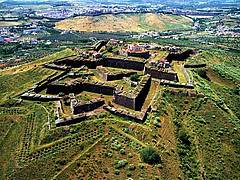The World Heritage
Committee on Saturday afternoon added the following sites to UNESCO’s World
Heritage List: Gonbad-e Qābus (Iran), Archaelogical Heritage of the Lenggong
Valley (Malaysia), The Landscape of Grand Pré (Canada); Heritage of Mercury
(Almadén and Idrija (Slovenia/Spain); Margravial Opera House Bayreuth
(Germany); Garrison Border Town of Elvas and its Fortifications (Portugal); and
Nord-Pas de Calais Mining Basin (France).
Gonbad-e
Qābus (Iran): The 53-metre high tomb built in 1006 A.D. for Qābus Ibn Voshmgir
near the ruins of the ancient city of Jorjan on the Gorgan River in northeast
Iran, bears testimony to the cultural exchange between Central Asian nomads and
the ancient civilization of Iran. The tower is the only remaining evidence of
Jorjan, a former centre of arts and science that was destroyed during the
Mongols’ invasion in the 14th and 15th centuries. It is an outstanding and
technologically innovative example of Islamic architecture that influenced
sacral building in Iran, Anatolia and Central Asia. Built of unglazed fired
bricks, the monument’s intricate geometric forms constitute a tapering cylinder
with a diameter of 17 to 15.5 metres, topped by a conical brick roof. It
illustrates the development of mathematics and science in the Muslim world at
the turn of the first millennium A.D.
Archaelogical
Heritage of the Lenggong Valley (Malaysia): Situated
in the lush Lenggon Valley, the property includes four archaeological sites in
two clusters which span close to two million years, one of the longest records
of early man in a single locality, and the oldest outside the African
continent. It features open-air and cave sites with Palaeolithic tool
workshops, evidence of early technology. The number of sites found in the
relatively contained area, suggests the presence of a relatively large,
semi-sedentary population with cultural remains from the Palaeolithic,
Neolithic and Metal ages.
The
Landscape of Grand-Pré (Canada): Situated
in the southern Minas Basin of Nova Scotia, the Grand Pré marshland and
archaeological sites constitute a cultural landscape bearing testimony to the
development of agricultural farmland using dykes and the aboiteau wooden sluice
system, started by the Acadians in the 17th century and further developed and
maintained by the Planters and present day inhabitants. The site - marked by
one of the most extreme tidal ranges in the world, averaging at 11.6 metres –
is also inscribed as a memorial to Acadian way of life and deportation, which
started in 1755. Over 1,300 hectares, the cultural landscape encompasses a
large expanse of polder farmland and archaeological elements of the towns of
Grand Pré and Hortonville, which was built by the British successors of the
Acadians. The landscape is an exceptional example of the adaptation of the
first European settlers to the conditions of the North American Atlantic coast
and an iconic place of remembrance of the Acadians’ deportation, known as the
Grand Dérangement.
Heritage of
Mercury Almadén and Idrija (Slovenia/Spain): The
property includes the mining sites of Almadén, where mercury (quicksilver) has
been extracted since Antiquity, and Idrija, where mercury was first found in
1490 A.D. The Spanish property includes buildings relating to its mining
history, including Retamar Castle, religious buildings and traditional
dwellings. The site in Idrija notably features mercury stores and
infrastructure, as well as miners’ living quarters, and a miners’ theatre. The
sites bear testimony to the intercontinental trade in mercury which generated
important exchanges between Europe and America over the centuries. The two
sites represent the two largest mercury mines in the world and were operational
until recent times.
Margravial Opera House Bayreuth (Germany): A
masterpiece of Baroque theatre architecture, built between 1745 and 1750, the
Opera House is the only entirely preserved example of its type where an
audience of 500 can experience Baroque court opera culture and acoustics
authentically, as its auditorium retains its original materials, i.e. wood and
canvas. Commissioned by Margravine Wilhelmine, wife of Frederick, Margrave of
Brandenburg–Beyreuth, it was designed by the renowned theatre architect
Giuseppe Galli Bibiena. As a court opera house in a public space, it
foreshadowed the large public theatres of the 19th century. The highly
decorated theatre’s tiered loge structure of wood with illusionistic painted
canvas represents the ephemeral ceremonial architectural tradition that was employed
in pageants and celebrations for princely self-representation.
Garrison
Border Town of Elvas and its Fortifications (Portugal): The site, extensively fortified from the 17th to 19th centuries,
represents the largest bulwarked dry ditch system in the world. Within its
walls, the town contains barracks and other military buildings as well as
churches and monasteries. While Elvas contains remains dating back to the 10th
century A.D., its fortification began when Portugal regained independence in
1640. The fortifications designed by Dutch Jesuit Padre João Piscásio Cosmander
represent the best surviving example of the Dutch school of fortifications
anywhere. The site also contains the Amoreira Aqueduct, built to enable the
stronghold to withstand lengthy sieges.
Nord-Pas de
Calais Mining Basin (France): Remarkable as a landscape shaped over three centuries of coal
extraction from the 1700s to the 1900s, the site consists of 109 separate
components over 120,000-hectare. It features mining pits (the oldest of which
dates from 1850) and lift infrastructure, slag heaps (some of which cover 90
hectares and exceed 140 metres in height), coal transport infrastructure,
railway stations, workers estates and mining villages including social habitat,
schools, religious buildings, health and community facilities, company
premises, owners and managers’ houses, town halls and more. The site bears
testimony to the quest to create model workers’ cities from the middle of the
19th century to the 1960s and further illustrates a significant period in the
history of industrial Europe. It documents the living conditions of workers and
the solidarity to which it gave rise.

Raul Ladeira
& Domingos Bucho/Municipality of Elvas -Fort of Graça. Aerial view
